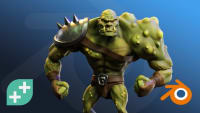Description
In this course, you will :
- Understand the Shader Editor's features when creating cycle nodes.
- Learn how to combine procedural texture with images and the distinction between procedural and non-procedural textures.
- Learn the fundamentals of complex materials such as glass and volumetric.
- Understand how UV can be useful in a variety of tasks.
- Learn the vocabulary so that terms like caustics, reflection, and refraction make sense.
- Understand how secondary objects such as "empties" can be used to control the appearance of a material.
- Learn how to use multiple materials on an object or generate random output.
Syllabus :
- Basic understanding of the node components
- Textures
- Using images as textures
- First practical example - a tile wall.
- Using the Object shape to place material
- How to use other objects to influence your material
- How to add material on a specific place
- Second practical Example - Texture a Lantern
- A closer look on the "Object Info" Node
- Working with glass and similar materials
- Third Practical Example - a bowl of candy
- Take a look at "Normals"
- Displacement
- Particles and material
- More Math and Vector Math
- Scratches








